
UNIDAD ASOCIADA "SISTEMAS AGROFORESTALES": ESTACIÓN FITOPATOLÓXICA DO AREEIRO - MISIÓN BIOLÓGICA DE GALICIA

UNIDAD ASOCIADA "SISTEMAS AGROFORESTALES": ESTACIÓN FITOPATOLÓXICA DO AREEIRO - MISIÓN BIOLÓGICA DE GALICIA |
||||
| Home » Publications » Papers in scientific journals and popular science publications » 2007 |
| 1258 | |
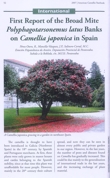 |
First Report of the
Broad Mite Polyphagotarsonemus latus Banks on Camellia japonica
in Spain Camellia Yearbook 2007 Pag: 52-56 |
|
Pérez-Otero, R., Mansilla-Vázquez, J.P., Salinero-Corral, M.C. Estación Fitopatolóxica de Areeiro, Subida a la Robleda s/n, Pontevedra, España ABSTRACT: This work constitutes the first report of the broad mite Polyphagotarsonemus latus Bank on camellia in Galicia. The mite was first detected in a Galician nursery on Camellia japonica, being its symptoms also observed in C. japonica plants growing in parks and gardens in our region. Symptoms on host are stunted and malformed terminal buds and leaves become rusty, reddish or purple coloured. So far measures against this pest were not adopted, and the extent of damages this pest would cause in the future is unknown. |
|
| 1119 | |
 |
Field Response to CPPU
Application in Kiwifruit (Actinidia deliciosa 'Hayward') Orchards
Treated with Hydrogen Cyanamide in Northwest Spain Acta Horticulturae Nº 753 October 2007 Pag: 555-557 |
|
M.C. Salinero¹, M.P. Piñón¹, M. J. Sainz² ¹ Estación Fitopatolóxica de Areeiro, Subida a la Robleda s/n, Pontevedra, España ² Departamento de Producción Vegetal, Universidad de Santiago de Compostela, Campus Universitario, 27002 Lugo, España ABSTRACT: In northwest
Spain, insufficient chilling hours result in low budbreak and flowering, and
consequently poor fruit production in orchards of Actinidia deliciosa
'Hayward'. Hydrogen cyanamide increases budbreak and flower production in this
and other mild climate regions. Application of CPPU
(N-[2-chloro-4-pyridyl]-N-phenylurea) after fruit set can also enhance fruit
production by increasing fruit size. Field experiments were carried out to
study the combined effects of hydrogen cyanamide and CPPU on fruit production
in two kiwifruit orchards at Pontevedra (NW Spain). |
|
| 90 | |
 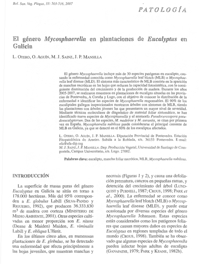 |
El género
Mycosphaerella en plantaciones de Eucalyptus en
Galicia BOLETÍN DE SANIDAD VEGETAL Volumen 33 Nº4 2007 4º Trimestre Pag: 503-516 |
|
L. Otero¹, O. Aguín¹, M. J. Sainz², J. P. Mansillal¹² ¹ Estación Fitopatolóxica de Areeiro, Subida a la Robleda s/n, Pontevedra, España ² Departamento de Producción Vegetal, Universidad de Santiago de Compostela, Campus Universitario, 27002 Lugo, España ABSTRACT:
Mycosphaerella genus comprises more than 30 species which are reported
pathogens of Eucalyptus, causing a disease known as Mycosphaerella leaf
blotch (MLB) or Mycosphaerella leaf disease (MLD). The main symptoms of
MLB are necrotic leaf spots, which significantly reduce photosynthetic activity
in the plant and consequently its growth and timber production. Eucalypt stands
were surveyed in Pontevedra, A Coruña and Lugo provinces (Galicia, NW
Spain) in 2005-2007, with the aim of studying the distribution of MLB and
identifying the Mycosphaerella species involved. Ninety percent of
Galician eucalypt stands showed trees with MLB symptoms, young tree stands
being more severely affected. By using molecular diagnostic techniques on
symptomatic leaf material, nine Mycosphaerella species and the anamorph
Pseudocercospora pseudoeucalyptorum were identified. Two species, M.
madeirae and M. aurantia, are first reported in Spain.
Mycosphaerella nubilosa can be considered as the main agent of MLB in
Galicia, since it was detected in 60% of the affected eucalypts. |
|
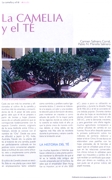 |
La CAMELIA y el
TÉ Publicación de la Sociedad Española de la Camelia Nº11 Dic 2007 Pag:25-30 |
|
Carmen Salinero Corral¹, Pablo N. Mansilla Salinero ¹ Estación Fitopatolóxica de Areeiro, Subida a la Robleda s/n, Pontevedra, España ABSTRACT: In spite of being widely consumed, tea beverage, elaborated from shoots and leaves from Camellia sinensis, is fairly unknown. This paper aims to approach this plant to the people: history (origin, traditional uses, preparation, and introduction in the Western countries), and preparation (white tea, green tea, oolong tea, and black and red tea, and the most commonly consumed, the 'tea blend'. |
|
 |
Primera
detección de la araña blanca (Polyphagotarsonemus latus
Banks) sobre Camellia japonica en España Publicación de la Sociedad Española de la Camelia Nº11 Dic 2007 Pag:15-17 |
|
Pérez Otero, R.¹, Mansilla Vázquez, J.P.¹, Salinero Corral, M.C.¹ ¹ Estación Fitopatolóxica de Areeiro, Subida a la Robleda s/n, Pontevedra, España ABSTRACT: The broad mite Polyphagotarsonemus latus Bank, has a large host range and is widely distributed in tropical and subtropical areas around the world. This mite was first detected on Camellia japonica in a Galician nursery, and their symptoms were also observed in Camellia japonica plants growing in parks and gardens in our region. Plants affected showed stunted growth, curling of tender and young leaves (usually to leaf underside) and bronzed leaves on the underside. |
|
 |
Effects of substrate
acidity on the growth of Camellia japonica cultivars International Camellia Journal 2006 Pag:38 |
|
Carmen Salinero ¹, Pilar Vela ¹ and María J. Sainz ² ¹ Estación Fitopatolóxica de Areeiro, Subida a la Robleda s/n, Pontevedra, España ² Departamento de Producción Vegetal, Universidad de Santiago de Compostela, Campus Universitario, 27002 Lugo, España ABSTRACT: Camellias are known to grow best in acidic soils. The optimum pH range for C. sinensis is 5.0 to 5.5, although for other Camellia species no study has dealt with differences in soil pH requirements. In our region, Camellia japonica is the most widespread species and our nurseries sell more than three million camellia plants a year, mostly cultivars belonging to this species. Thus, in the present work, the growth response of three C. japonica and hybrid cultivars to different levels of substrate acidity was studied. |
|
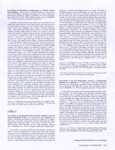 |
Fisrt report of
Phytophthora pseudosyringae on chesnut nursery stock in
Spain Plant Disease November 2007 Pag:1517 |
|
C. Pintos Varela, J. P. Mansilla Vázquez, O. Aguín Casal and C. Rial Martínez Estación Fitopatolóxica de Areeiro, Subida a la Robleda s/n, Pontevedra, España ABSTRACT: Phytophthora pseudosyringae was reported to cause stem necrosis and collar rot of deciduous tree species in Europe. In 2006, symptomatic Castanea sativa seedlings were received in our laboratory. On the basis of its combination of morphological and physiological characters, pathogenicity and molecular techniques, the fungus was identified as P. pseudosyringae, being the first report of this species in Spain. |
|
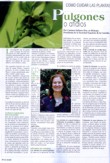 |
Pulgones o
afidios La Moda Verano 2007 Nº611 Pag: 88 |
|
Carmen Salinero Corral Estación Fitopatolóxica de Areeiro, Subida a la Robleda s/n, Pontevedra, España ABSTRACT: Aphids are a group of insects, of which more than 500 are pests occurring in different plant species, causing both direct and indirect damages. In the present work, a description of the most important aphid species , and the control measures carried out in every case are described: chemical methods, preventive measures, making special emphasis in the biological control methods using parasites and predators. |
|
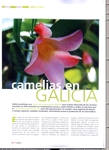 |
Camelias en
Galicia Tecnogarden mayo 2007 Nº114 Pag:34-40 |
|
Carmen Salinero Corral Estación Fitopatolóxica de Areeiro, Subida a la Robleda s/n, Pontevedra, España ABSTRACT:The genus
Camellia was introduced in Galicia (NW Spain) in the 19th century and
was grown mostly at Pazos belonging to the Galician nobility finding adequate
conditions for its culture: rain, fertile and acid soil. At present, Camellias
can be seen growing almost in every Galician garden. |
|
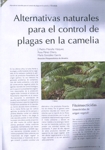 |
Alternativas naturales
para el control de plagas en la camelia Camelia Nº 10 Julio 2007 Pag:33-36 |
|
J. Pedro Mansilla Vázquez, Rosa Pérez Otero, María González García Estación Fitopatolóxica de Areeiro, Subida a la Robleda s/n, Pontevedra, España ABSTRACT: In the last years, plant pests and diseases are mainly controlled with chemicals. However, their extensive use has caused important damage to the environment, thus, at present, institutions responsible for crop protection are reducing the number of chemicals available in the market, limiting or prohibiting the use of those that would mean a risk for human or animal health, or that could affect beneficial organisms living in nature. Plants themselves provide control measures, by producing substances with insecticide effects, popularly known as 'botanical insecticides' or 'botanicals'. There are also some minerals that have the same properties, they are called 'mineral insecticides'. In the present work some of these natural pesticides are described, providing information on their effects on pests, and some guidelines on how to prepare them. |
|
 |
Los nemátodos
entomopatógenos y su aplicación para el control biológico
de plagas de insectos Nutri-fitos Extra 2007 Nº113 Pag:42-46 |
|
A. Picoaga, A. Abelleira, J.P. Mansilla Estación Fitopatolóxica de Areeiro, Subida a la Robleda s/n, Pontevedra, España ABSTRACT: At present,
the use of pesticides is being limited, in favor of biological control agents
that reduce insect pests affecting plant species all around the world. The
entomopathogenic nematodes are insect parasitoids highly effective as
bioinsectides, since they are symbiotically associated with bacteria that kill
the host insect within 24-48 h. These organisms are being used successfully to
control soil insect pests, such as weevils, scarabs or crane flies.
|
|
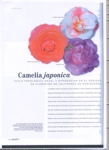 |
Camelia
japonica Plantflor 2007 Nº123 Pag:100-105 |
|
Carmen Salinero ¹, Pilar Vela ¹, María J. Sainz ² ¹ Estación Fitopatolóxica de Areeiro, Subida a la Robleda s/n, Pontevedra, España ² Departamento de Producción Vegetal, Universidad de Santiago de Compostela, Campus Universitario, 27002 Lugo, España ABSTRACT: In Galicia,
almost every park and garden has a specimen of Camellia japonica, the
ornamental camellia species more widespread in the world. In Galicia, the
blooming period of C. japonica generally extends from September to May,
but there are important differences among cultivars that have not been studied
so far. The knowledge of camellia blooming period is crucial to facilitate
culture practices and for its commercialization. |
|
 |
Insecticidas de origen
vegetal para el control de plagas La Moda 2007 Pag:70-71 |
|
Carmen Salinero Corral Estación Fitopatolóxica de Areeiro, Subida a la Robleda s/n, Pontevedra, España ABSTRACT: In the last years, plant pests and diseases are mainly controlled with chemicals. However, their extensive use has caused important damage to the environment, thus, at present, institutions responsible for crop protection are reducing the number of chemicals available in the market, limiting or prohibiting the use of those that would mean a risk for human or animal health, or that could affect beneficial organisms living in nature. Plants themselves provide control measures, by producing substances with insecticide effects, popularly known as 'botanical insecticides' or 'botanicals'. There are also some minerals that have the same properties, they are called 'mineral insecticides'. In the present work some of these natural pesticides are described, providing information on their effects on pests, and some guidelines on how to prepare them. |
|